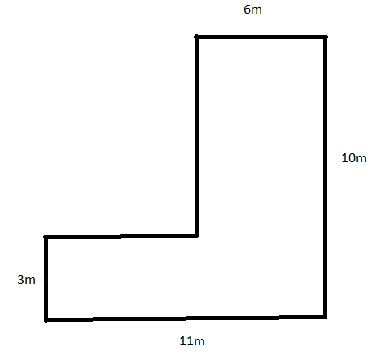
The diagram shows a floor plan 10m not to scale. Calculate the area.


Answer
419.7k+ views
Hint: According to the question, the area of irregular rectangles can be calculated in parts. As the above diagram is presented, we have to divide that figure in two regular shapes. We have to calculate the area of the two regular rectangles separately, and then add the final area that will be the final area of this irregular rectangle.
Formula used: \[\text{area of rectangle} = \text{length} \times \text{breadth}\]
Complete step-by-step solution:
Here we divide the given shape in two rectangles as:

As the \[\text{area of rectangle} = \text{length} \times \text{breadth}\]
So, we will be finding the area of rectangle A
Given, \[length = 3m\], \[breadth = 11m\]
So, \[\text{area of rectangle} = \text{length} \times \text{breadth} = 3 \times 11 = 33\]
Now, finding the area of rectangle B, we get:
Given, \[length = 7m\], \[breadth = 6m\]
Calculating the area, we get:
\[\text{area of rectangle} = \text{length} \times \text{breadth} = 7 \times 6 = 42\]
Now, adding both the areas of rectangle A and rectangle B, we get:
\[ = 33 + 42 = 75\]
So, the area of the irregular rectangle is 75 inches.
Note: A rectangle is a figure having four sides with four right angles. It has internal angles of \[{90^ \circ }\]. It is also called a four-sided polygon. The rectangle is always characterized in two parts. One is the length and the second one is the width. The size of the length and the width is always different. If their size is the same, then the figure is called a square instead of a rectangle.
Formula used: \[\text{area of rectangle} = \text{length} \times \text{breadth}\]
Complete step-by-step solution:
Here we divide the given shape in two rectangles as:

As the \[\text{area of rectangle} = \text{length} \times \text{breadth}\]
So, we will be finding the area of rectangle A
Given, \[length = 3m\], \[breadth = 11m\]
So, \[\text{area of rectangle} = \text{length} \times \text{breadth} = 3 \times 11 = 33\]
Now, finding the area of rectangle B, we get:
Given, \[length = 7m\], \[breadth = 6m\]
Calculating the area, we get:
\[\text{area of rectangle} = \text{length} \times \text{breadth} = 7 \times 6 = 42\]
Now, adding both the areas of rectangle A and rectangle B, we get:
\[ = 33 + 42 = 75\]
So, the area of the irregular rectangle is 75 inches.
Note: A rectangle is a figure having four sides with four right angles. It has internal angles of \[{90^ \circ }\]. It is also called a four-sided polygon. The rectangle is always characterized in two parts. One is the length and the second one is the width. The size of the length and the width is always different. If their size is the same, then the figure is called a square instead of a rectangle.
Recently Updated Pages
The correct geometry and hybridization for XeF4 are class 11 chemistry CBSE

Water softening by Clarks process uses ACalcium bicarbonate class 11 chemistry CBSE

With reference to graphite and diamond which of the class 11 chemistry CBSE

A certain household has consumed 250 units of energy class 11 physics CBSE

The lightest metal known is A beryllium B lithium C class 11 chemistry CBSE

What is the formula mass of the iodine molecule class 11 chemistry CBSE

Trending doubts
Explain the system of Dual Government class 8 social science CBSE

What is Kayal in Geography class 8 social science CBSE

Who is the author of Kadambari AKalidas B Panini C class 8 social science CBSE

In Indian rupees 1 trillion is equal to how many c class 8 maths CBSE

Advantages and disadvantages of science

Write the smallest number divisible by both 306 and class 8 maths CBSE





